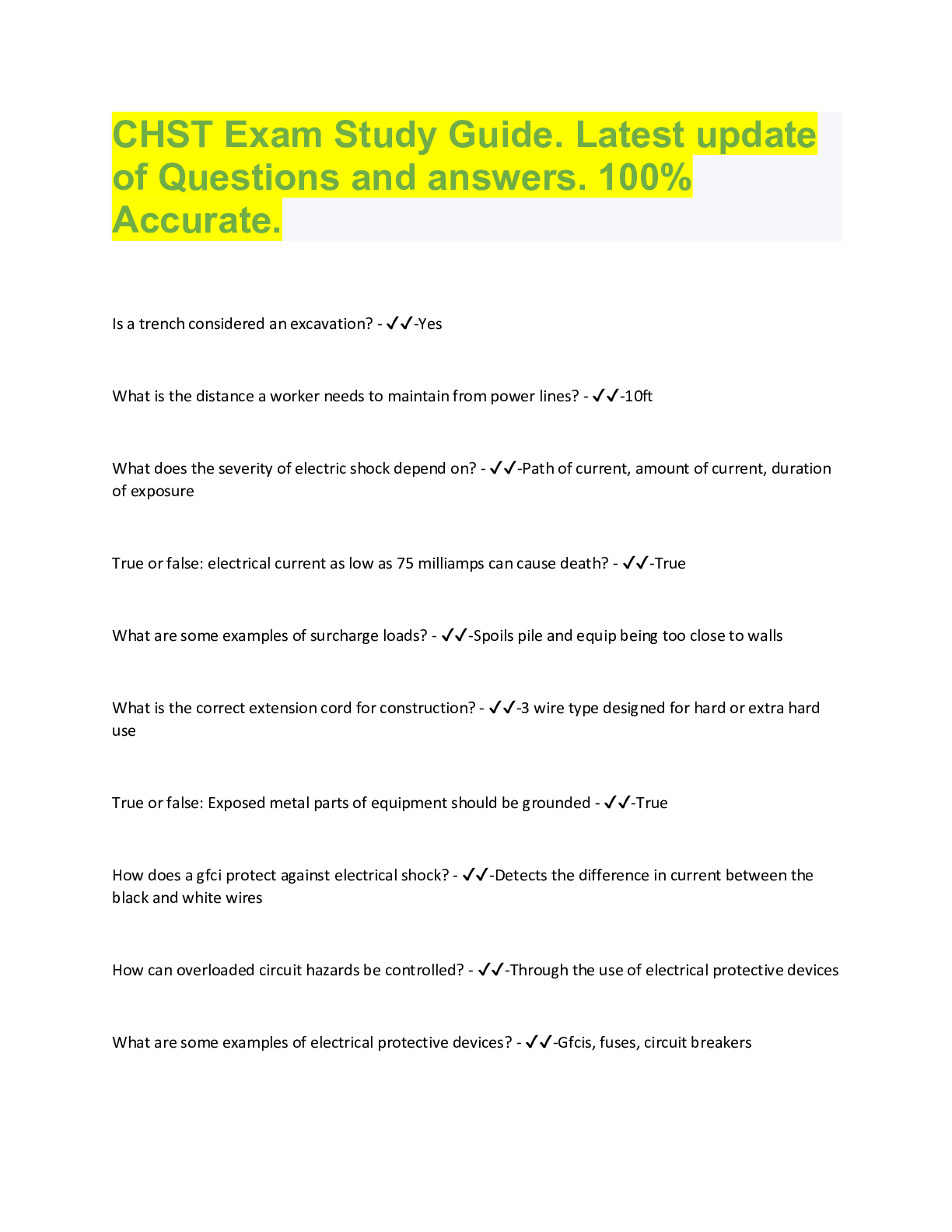
Pearson Edexcel_History_8HI0/1F Question Paper_2020 | Paper 1: Breadth study with interpretations
$ 6.5

CHST Exam Study Guide | 133 Questions with 100% Correct Answers
BIOL 121 CHAPTER 19 THE ENDOCRINE SYSTEM Human Anatomy, 7e (Martini/Timmons/Tallitsch) Chapter 19 The Endocrine System 1) The cells of the endocrine and nervous systems work together to A) provi ... de widespread physiological effects throughout the body. B) provide long-lasting effects on a systemic basis. C) monitor and adjust physiological activities in the body at any given moment. D) affect target organs, which are restricted to nerve, gland, muscle, and fat cells. E) provide gradual onset of the systemic effects. 2) Which of the following is (are) unique to the suprarenal medullae? A) The suprarenal medulla is a modified sympathetic ganglion. B) Some cells of the suprarenal medulla secrete epinephrine. C) The systemic effects of the suprarenal medulla are long lasting. D) Some cells of the suprarenal medulla secrete norepinephrine. E) All of the answers are correct. 3) Hormones influence cellular operations by changing which of the following features of cytoplasmic enzymes? A) types B) quantities C) activities D) All of the answers are correct. E) None of the answers are correct. 4) Hypothalamic centers regulate nervous and endocrine system activities by A) direct neural control over endocrine cells. B) acting as an endocrine organ, releasing ADH and oxytocin. C) secreting regulatory hormones to control pituitary gland activities. D) All of the answers are correct. E) None of the answers are correct. 5) Changes in the composition of extracellular fluid are called A) hormonal stimuli. B) humoral stimuli. C) neural stimuli. D) endocrine reflexes. E) None of the answers are correct. 6) Negative feedback on a releasing hormone by the presence of a peripheral hormone is an example of which type of endocrine reflex? A) humoral B) hormonal C) neural D) central E) inhibitory 7) Amino acid derivative hormones and closely related compounds are structurally similar to individual amino acids, and include A) catecholamines and thyroid hormones. B) lipids and epinephrine. C) melatonin. D) steroids. E) eicosanoids. 8) Most endocrine reflexes are controlled by A) the nervous system. B) positive feedback. C) negative feedback. D) autoregulation. E) All of the answers are correct. 9) All endocrine structures develop from ________ tissue. A) connective B) neural C) epithelial D) muscle E) None of the answers are correct. 10) Hormones can alter cellular operations by changinG A) the quantities of enzymes. B) the activities of enzymes in the cell. C) the types of enzymes in the cell. D) All of the answers are correct. E) None of the answers are correct. 11) A lipid that has been implicated in causing heart and blood vessel problems, but is necessary for the production of corticosteroids, is A) sugar. B) unsaturated fat. C) cholesterol. D) aldosterone. E) None of the answers are correct. 12) Which of the following organs secrete hormones? [Show More]
Last updated: 3 years ago
Preview 1 out of 11 pages

Buy this document to get the full access instantly
Instant Download Access after purchase
Buy NowInstant download
We Accept:

Can't find what you want? Try our AI powered Search
Connected school, study & course
About the document
Uploaded On
Feb 12, 2021
Number of pages
11
Written in
All
This document has been written for:
Uploaded
Feb 12, 2021
Downloads
0
Views
93
Scholarfriends.com Online Platform by Browsegrades Inc. 651N South Broad St, Middletown DE. United States.
We're available through e-mail, Twitter, Facebook, and live chat.
FAQ
Questions? Leave a message!
Copyright © Scholarfriends · High quality services·